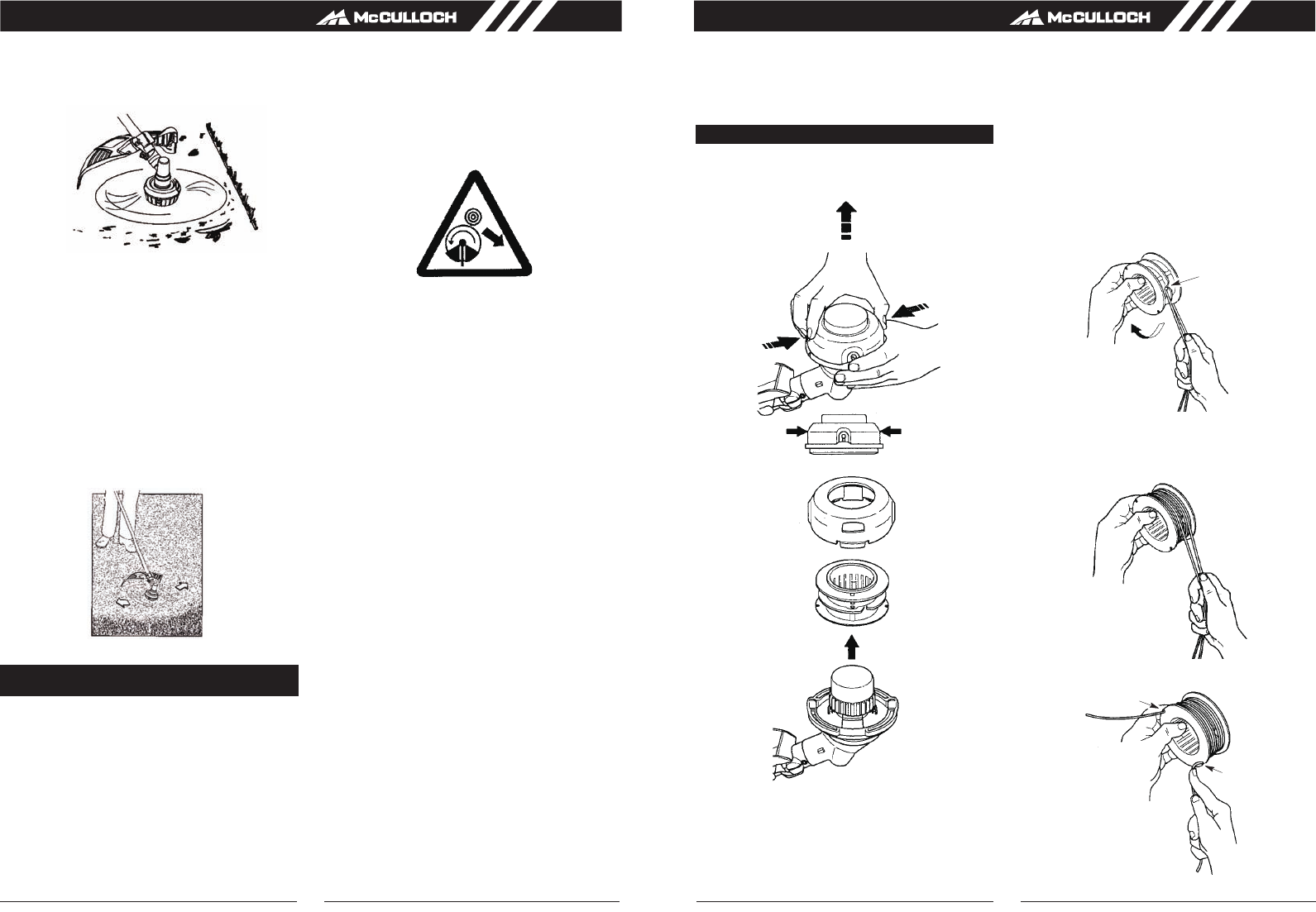
1211
• Blade Thrust is a reaction that only occurs when
using a bladed unit. This reaction can cause serious
injury. Carefully study this section. It is important that
you understand what causes blade thrust, how you
can reduce the chance of its occurring, and how you
can remain in control of unit if blade thrust occurs.
• WHAT CAUSES BLADE THRUST - Blade Thrust
can occur when the spinning blade contacts an object
that it does not cut. This contact causes the blade to
stop for an instant and then suddenly move or “thrust”
away from the object that was hit. The “thrusting”
reaction can be violent enough to cause the operator
to be propelled in any direction and lose control of the
• Maintain good firm footing while using the unit. Do this
by planting feet firmly in a comfortable apart position.
• Cut while swinging the upper part of your body from
right to left.
• As you move forward to the next area to cut, be sure
to maintain your balance and footing.
Bring the engine to cutting speed before entering the
material to be cut. If the blade does not turn when you
squeeze the throttle trigger, make sure shaft is fully
inserted into the engine.
Always release the throttle trigger and allow engine to
return to idle speed when not cutting. The blade should
not turn while the engine is running at idle. If the blade
turns at idle, do not use your unit. Refer to the
CARBURETOR ADJUSTMENT section or contact your
authorized service dealer.
WARNING: The operator or others must not try to
clear away cut material with the engine running or
the blade turning to avoid serious injury. Stop
engine and blade before removing materials
wrapped around blade or shaft.
WARNING: Never use wire, rope, string, etc.,
which canbreak off and become a dangerous
missile.
•
Cut only grass, weeds, and woody brush up to 1 cm in
diameter with the weed blade. Do not let the blade
contact material it cannot cut such as stumps, rocks,
fences,metal, etc., or clusters of hard, woody brush
having a diameter greater than 1 cm.
• Keep the blade sharp. A dull blade is more likely to
snag and thrust.
• Cut only at full throttle. The blade will have maximum
cutting power and is less likely to bind or stall.
• “Feed” the blade deliberately and not too rapidly. The
blade can thrust away if it is fed too rapidly.
• The grass is cut down with a sideways, swinging
movement, where the movement from right-to-left is
the cutting stroke and the movement from left-to-right
is the return stroke. Let the left-hand side of the blade
do the cutting.
• Use the shoulder strap and keep a firm grip on the unit
with both hands. A properly adjusted shoulder strap
will support the weight of the unit, freeing your arms
and hands to control and guide the cutting motion.
• Keep feet comfortably spread apart and braced for a
possible sudden, rapid thrust of unit. Do not
overreach. Keep firm footing and balance.
• Keep blade below waist level; it will be easier to
maintain control of unit.
• Do not raise the engine above your waist as the blade
can come dangerously close to your body.
• Do not swing unit with such force that you are in
danger of losing your balance.
GB GB
2. Remove any remaining line.
3. Clean dirt and debris from all parts. Replace spool if it
is worn or damaged.
4. Replace with a pre-wound spool, or replace line using
a 4,5 metres length of 2,4 mm diameter McCulloch
brand line.
5. When installing new line on an existing spool, hold the
spool as shown.
6. Bend the line at the midpoint and insert the bend into
the slot in the center rim of the spool. Ensure line
snaps into position in the slot.
7. With your finger between the lines, wrap the lines
evenly and firmly around the spool in a clockwise
direction.
8. Position the lines in the guide slots.
• REPLACING THE LINE
1. Press the tabs on the side of the trimmer head and
remove cover and spool.
MAINTENANCE INSTRUCTIONS
Tab
Tab
Cover
Spool
Slot
Guide slot
Guide slot
OPERATING INSTRUCTIONS FOR USE WITH
WEED BLADE
• TRIMMING PROCEDURES
TRIMMING / MOWING
When properly equipped with a cutting attachment guard
and cutting head, your unit will trim unsightly weeds and
tall grass in those hard-to-reach areas - along fences,
walls, foundations and around trees. It can also be used for
scalping to remove vegetation down to the ground for eas-
ier preparation of a garden or to clean out a particular area.
NOTE: Even with care, trimming around foundations, brick
or stone walls, curves, etc., will result in above normal
string wear.
Swing trimmer with a sickle-like motion from side to side.
Do not tilt the cutting head during the procedure.Test area
to be trimmed for proper cutting height. Keep cutting head
at same level for even depth of cut (Fig. 12A).
SWEEPING - The fanning action of the rotating line can
be used to blow away loose debris from an area. Keep
the line parallel to and above the area surface and swing
the tool from side to side.
Sweeping
Fig. 12A
unit. The uncontrolled unit can cause serious injury if
the blade contacts the operator or others.
• WHEN BLADE THRUST OCCURS - Blade Thrust
can occur without warning if the blade snags, stalls, or
binds. This is more likely to occur in areas where it is
difficult to see the material being cut. By using the unit
properly, the occurrence of blade thrust will be
reduced and the operator will be less likely to lose
control.











